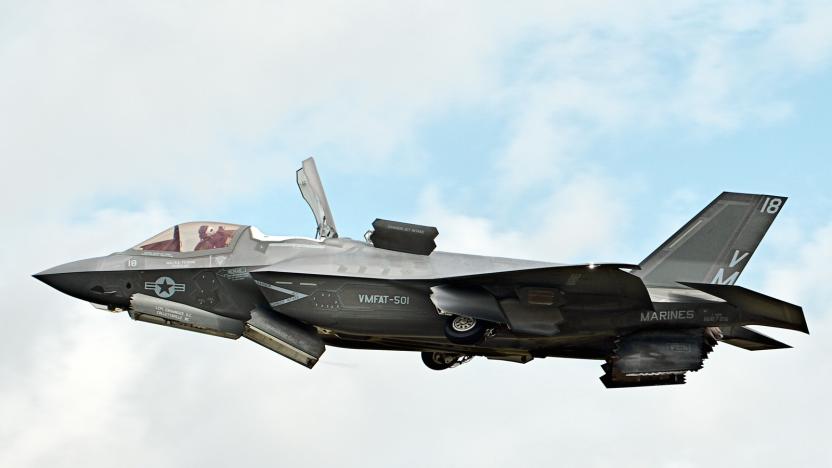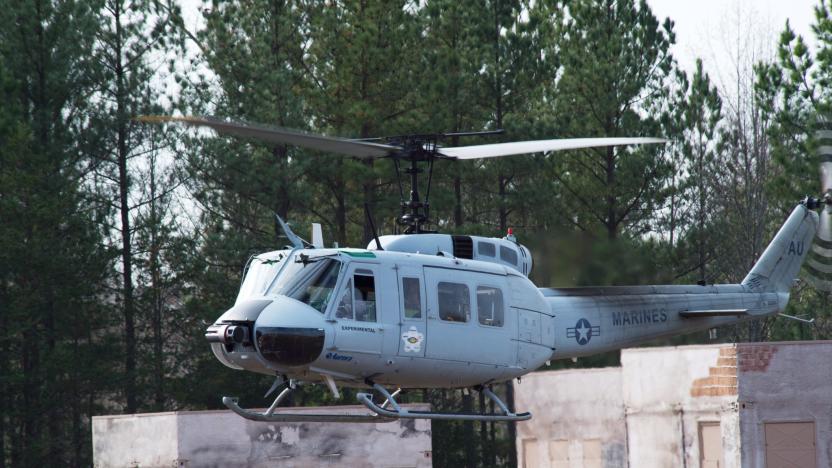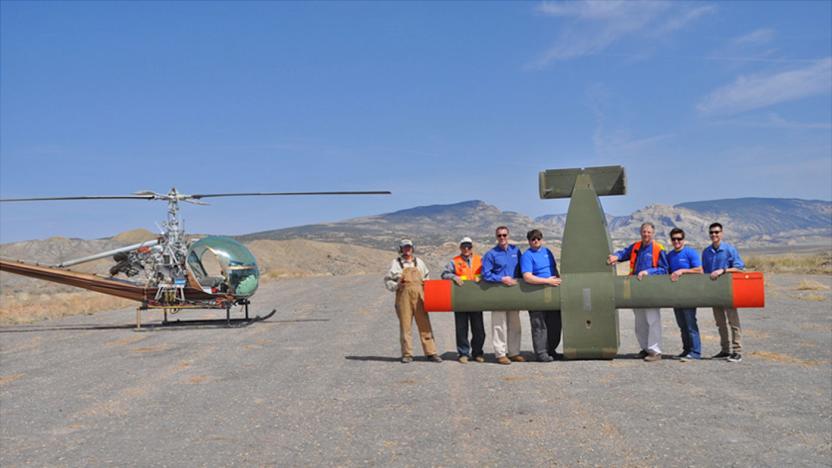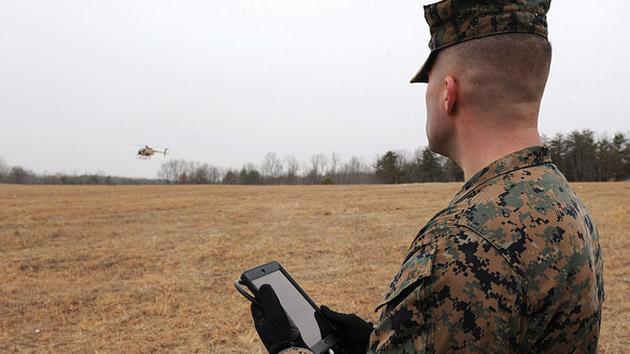marines
Latest

F-35 may see combat in 2018
After a very long and problematic development process, the F-35 Lightning II is about to serve on the front lines. The US Marine Corps is deploying the F-35B (the short takeoff and vertical landing variant) to ships in the Central and Pacific Command theaters in the spring and summer of 2018. The 13th Marine Expeditionary Unit is traveling aboard the USS Essex, which is headed to the Middle East, while the 31st will be attached to the USS Wasp and might head to the coast of North Korea.

Autonomous helicopter completes Marine resupply simulation
Drones have become a part of the modern battlefield, but what about autonomous full-size aircraft? Aurora Flight Sciences just successfully demonstrated its self-flying setup, the Autonomous Aerial Cargo Utility System (AACUS), enabling an older helicopter to fly itself at soldiers' requests. In the future, troops in the field could use this tech to order autonomous supply deliveries with nothing more complicated than a tablet.

US Marines test glider drones that drop supplies to troops
Since it's not always possible to deliver supplies to troops in dangerous regions by land or sea, the Pentagon uses steerable parachutes called Joint Precision Airdrop System or JPADS. They're expensive and difficult to retrieve, though, that's why the US Marines tested a much cheaper and more practical alternative: disposable glider drones that cost only around $1,500 to $3,000 make. Their creator, Logistics Glider, build them out of plywood, household hardware and off-the-shelf electronics, yet they're capable of carrying up to 1,600 pounds for up to 74 nautical miles. That's thrice JPAD's range for a fraction of what the parachute system costs ($29,700).

Marines' online nude photo scandal leads to 21 criminal cases
Feds have filed a total of 21 criminal cases after two months of investigating the nude photo scandal that rocked the US Marine Corps. According to AP, the investigation team called Task Force Purple Harbor scoured 200 websites for nude and semi-nude images of male and female soldiers on their own and with the help of some tools and software. It was a tough task, since perpetrators keep posting, deleting and reposting under different pseudonyms. Plus, some websites are exclusive to members and kick anyone who doesn't contribute.

Two Marines punished for online misconduct under new policy
Two Marines have been disciplined for posting disrespectful comments about a female soldier on social media, The Washington Post reports. It's the first time the Marine Corps has officially punished someone for online misconduct since last month's nude photo scandal.

Marines had swapped nude photos of female soldiers since last May
Last Saturday, the California-based Center for Investigative Reporting revealed that a Facebook group, Marines United, had been distributing nude photos of servicewomen for some time. US Naval authorities immediately began investigating hundreds of Marines, but more details have emerged in the days since -- including the discovery of another image posting board where users traded photos of women from all service branches, even requesting some by name.

Facebook group hosted naked photos of women soldiers
Private Facebook groups can be valuable discussion areas for like-minded people, but they can also promote toxic behavior in the wrong circumstances. The Center for Investigative Reporting has revealed that the US' Naval Criminal Investigative Service is looking into a Facebook group, Marines United, that was used by soldiers in the US and UK (including the Marine Corps, Navy Corpsman and Royal Marines) to share naked photos of servicewomen. While the group has had some above-board discussions, according to one anonymous veteran, it has been dominated by "creepy, stalker-like" photography, revenge porn and the vile talk to match. Over two dozen of the women were identified by their names and positions.

ICYMI: The US Marines want your robots
try{document.getElementById("aol-cms-player-1").style.display="none";}catch(e){}Today on In Case You Missed It: The US Marine Corps announced its latest Innovation Challenge for robots that can handle dull, dirty or dangerous work autonomously, leaving humans free for more important tasks. Meanwhile the University of Pennsylvania has a researcher flying a quadcopter through 45-degree angle window openings at top speeds, with few extra onboard sensors. The algorithm behind it is neat, even if the potential applications make us uncomfortable. You may already know why we should be covering up our computer webcams, but here's more ammo if that's needed. As always, please share any interesting tech or science videos you find by using the #ICYMI hashtag on Twitter for @mskerryd.

Marines send its 'AlphaDog' robot to the farm
The Legged Squad Support System (LS3, or AlphaDog) won't be part of the near-future Marine corps. Following years of development and improvements through DARPA and Boston Dynamics, the robot was deemed too loud and difficult for deployment. The robo pack-mule was meant to assist soldiers in the field by carrying substantial equipment loads on patrol, with built-in gas engines and voice control adding a degree of freedom compared to older robots. However, when the 'bot was put into demonstrative field tests, Kyle Olson, a spokesman for the Marines' Warfighting Lab explained BigDog's limits were also on show:"As Marines were using it, there was the challenge of seeing the potential possibility because of the limitations of the robot itself," Olson said. "They took it as it was: a loud robot that's going to give away their position."

The Marines start training Google's 160-pound robo-dog Spot
Spot, the silent robo-dog made by Google-owned company Boston Dynamics, enjoyed the great outdoors for a week back in September. Not to fetch sticks or roll around in the grass, but to train... with the Marines. It's gone a long way since its time stalking indoors, getting kicked by well-meaning engineers. The corps tested Spot's ability to traverse terrains rougher than concrete floors, such as hills, woodlands and cities, controlling it from 500 meters away with a laptop and a video game controller. It was apparently so easy to pilot the quadruped, even a four-year-old could do it.

Navy AR goggles turn a golf course into a battleground
Marines on a sunny golf course in Quantico, Virginia, this week demonstrated a pair of augmented reality glasses that simulate combat scenarios. The Office of Naval Research recently completed development of the goggles and this week hooked them up to a larger training system known as the Augmented Immersive Team Trainer for the first time. Representatives from the Army, Navy and Marine Corps showed up at Marine Corps Base Quantico to see the AITT in action. The AR glasses themselves have a wider field of view than similar products on the commercial market, and the full AITT experience incorporates real-life weapons props, binoculars and other physical equipment necessary in a potential combat zone. "For Marines, this system increases their situational awareness, whether for training or operations, giving them a wider aperture for information to help make better decisions," ONR action officer Le Nolan said.

Watch an AlphaDog robot venture into (simulated) battle for the first time
They grow up so fast, don't they? It seems like only yesterday that Boston Dynamics' AlphaDog (aka LS3) robot was finding its legs, and yet it has already gone out on training exercises with the US Marine Corps for the first time. The cargo-hauling machine dutifully trotted behind a Marine squad traversing a simulated combat zone in Hawaii, proving that it could both navigate rough terrain and resupply other platoons that would otherwise have to wait for an ATV.

US Navy fine tunes seafaring laser weapon and unmanned robocopters (video)
That electromagnetic railgun is cool and all, but it's not the Navy's only wargadget in progress. Apparently, the Armed Forces branch has also been working tirelessly to improve its ship-mounted lasers and autonomous helicopters since we'd last heard about them. The new laser prototype, in particular, is a beefed-up version of what we saw in 2013. It's capable of firing high-energy beams for $1 per shot, providing ships a low-cost alternative to weapons that require expensive ammunition. Within the past months, Navy engineers have consolidated the weapon's controls, so a single person can target, track and fire at threats like unmanned aircraft and attack boats using only a video game-like controller. The Navy wants to deploy this cost-effective death ray this summer aboard the same ship its predecessor occupied (the USS Ponce in the Gulf Sea), but it's still going through some final-stage adjustments.

Navy plans ship-based LTE for close-quarters communication
Bandwidth is a precious commodity on military vessels. Ships in the US Navy fleet are generating more data, but the pipe it's getting pumped through isn't getting any larger. What's more, with limited connectivity options on the table, the sea-faring military wing is missing out on all the smartphone and app store fun. Rather than turn green with envy, or turning their dress whites is for camouflage cargo pants, the Navy is beefing up its mobile tech arsenal, beginning with the U.S.S. Kearsarge, U.S.S. San Antonio and U.S.S. Whidbey Island. The ships will serve as test beds for a nautical LTE system, with a range of about 25 miles. The 4G network will serve as a localized platform for wirelessly feeding data to sailors, as well as a way for the enlisted to connect to the outside world. On the backend, the Marines are working on a new satellite broadband service that should be able to provide ships with 300 megabits of shared bandwidth. Satellite internet and off-grid LTE might induce yawns in some, but they're certainly a major part of modernizing our fighting forces. For more info, check out the source link.

Navy awards Aerovel Flexrotor contract to develop marine surveillance tech
The high seas and UAVs go together like -- well, they go together really well. The Navy's cooking up 3D laser imaging technology for spotting pirates and the like, but it will need some aircraft for the task. Right on cue, a helicopter / airplane hybrid for maritime surveillance is inching toward reality. Aerovel's Flexrotor, an ultra-compact craft with a wing span of three meters (9.8 feet) and a weight of just 19.2 kg (42.3 lb), has already been demonstrated to switch between horizontal and vertical flight, but the next step is enhancing its propulsion system to improve its performance for longer distances and in windier conditions. Today the Office of Naval Research (ONR) awarded the company a contract for developing that tech. For now, you can check out a video of the Flexrotor's first test flight, which demoes the UAV transitioning from vertical and horizontal orientation and back again.

Marines field test solar panels by day, watch Gomer Pyle by night
United States Marines are among the best-equipped soldiers on the planet, but more gadgets mean extra batteries to haul, adding dozens of pounds on extended missions. Troops in Afghanistan recently put that hot Middle Eastern sun to use, swapping spare batteries for placemat-size solar panels on a three-week patrol. Batts were replaced with extra bullets, so the soldiers didn't get off easy, but they were also able to reduce generator usage, making a significant dent in fuel consumption. It will be several years before all soldiers charge their radios, night vision goggles, and GPS devices using the sun, but the Marine Corps hopes to cut fuel use in half by 2025, so it's only a matter of time before solar-powered gadgets have a more permanent home on the battlefield. Sha-zam!

AIRPrint performs ranged fingerprint scanning, won't let the terrorists win
While ears may be the new biometric du jour, Advanced Optical Systems (AOS) is doing its best to keep fingerprints as the preferred method for identifying enemies of the state. The company has built a fingerprint scanner with the ability to accurately read a print up to two meters away, and our military views the system as a means to reduce the risk to soldiers at security checkpoints all over the world. The AIRPrint system is a significant upgrade over previous biometric security systems because it allows a person's identity to be confirmed by military personnel from behind the safety of a blast wall or armored vehicle, which keeps our serviceman out of harm's way. AIRPrint uses a source of polarized light and two 1.3 megapixel cameras (one to receive vertically polarized light and another to receive horizontally polarized light) in order to produce an accurate fingerprint. The prototype is able to scan and verify a print in under five seconds, but the device can presently only process one finger at a time, and that finger must stay a fixed distance from the cameras to get a precise reading. Despite these current limitations, AOS claims that soon the equipment will be capable of reading five prints simultaneously while a person is moving toward or away from the device. The system will be ready for market in the third quarter of this year, which is bad news for terrorists and soccer hooligans, but a windfall for Big Brother.

Lockheed Martin and Kaman's unmanned helicopter wins military contract (video)
When developing an unmanned vehicle there are two paths to choose from: create an entirely fresh design with no room for a carbon-based pilot, or simply take an existing craft and make it self-sufficient. That's the direction Lockheed Martin chose for its submission to the the joint Army Marines Autonomous Technologies for Unmanned Air Systems (ATUAS) program, and it turned out to be a winner. The idea is to create an autonomous helo that can resupply military forces, and Lockheed Martin started with a Kaman K-Max cargo chopper (demo'd after the break), capable of lifting 6,000lbs plus one pilot -- who was made optional. This customized K-Max can place its cargo within a 10 meter drop zone after flying 200km or more, but a principal advantage of this submission is that you can still put a pilot in there and use it like a traditional heavy lifter, while the competition from Boeing was a bespoke UAV with no room for meatbags. It's unclear when exactly this sentient K-Max will be hitting battlefields, but hopefully the Army and Marines come up with some other, rewarding jobs for their pilots, because between this and the Unmanned Aircraft Systems Roadmap released earlier this year that particular job market could be getting tight. Update: Bo from Lockheed Martin wrote in to let us know of a different video we've added after the break featuring higher production values, more guitar solos, and plenty of autonomous cargo liftin'.

Marines field autonomous support vehicles based on winning robot design (video)
Since their third-place finish in the 2007 DARPA Urban Challenge, TORC Technology's had quite a climb -- the company founded by Virginia Tech graduates has since provided IED-scouting Humvee kits to the US Military, and a vehicle for the blind uses the drive-by-wire platform that they designed. Now, the Marines are testing a TORC kit called the Ground Unmanned Support Surrogate (GUSS), which autonomously navigate off-road terrain. Designed to accompany ground troops, the four prototypes only move at 5 MPH, but carry up to 1800 pounds, and can automatically follow troops (or other GUSS) at a distance while shouldering their loads. A one pound transmitter -- the WaySight -- can show the GUSS where to go, or optionally enable direct control for soldiers who prefer things the old-fashioned way. Personally, we love the smell of autonomy in the morning, don't you? See it in action after the break.

Hello Kitty Online joins the Toys for Tots charity drive
Hello Kitty and Toys for Tots, two names that are pretty recognizable at first glance. Well, the two are teaming up for the holiday season, as Aeria Games is using Hello Kitty Online as a platform to drive charitable contributions in a pretty unique way. Instead of offering a buyable pet and giving the proceeds to Toys for Tots, HKO players will get to search the grand virtual lands of Sanrio for Short Sticks, Webley Webs, Shells, and Bramble's Comfort. Each set of items collected will go to creating a special in-game Crab Plush Toy for you and will add one more donation to Aeria's real life toy drive. That's right: An in-game quest with a real life reward of helping get toys to children for the holidays. That's one quest that you can't drop from your log. GMs will be picking up item sets on December 14th, 15th, and 16th. For the full information on what needs to be collected to make a set, check out the event page on HKO's main website. Don't miss out on this great chance to help children in need!











